Physical Address
304 North Cardinal St.
Dorchester Center, MA 02124
The epithelium is a tightly cohesive sheet of cells that covers or lines body surfaces and forms the functional units of secretory glands . The main characteristics of epithelia are summarized in Box 1-A .
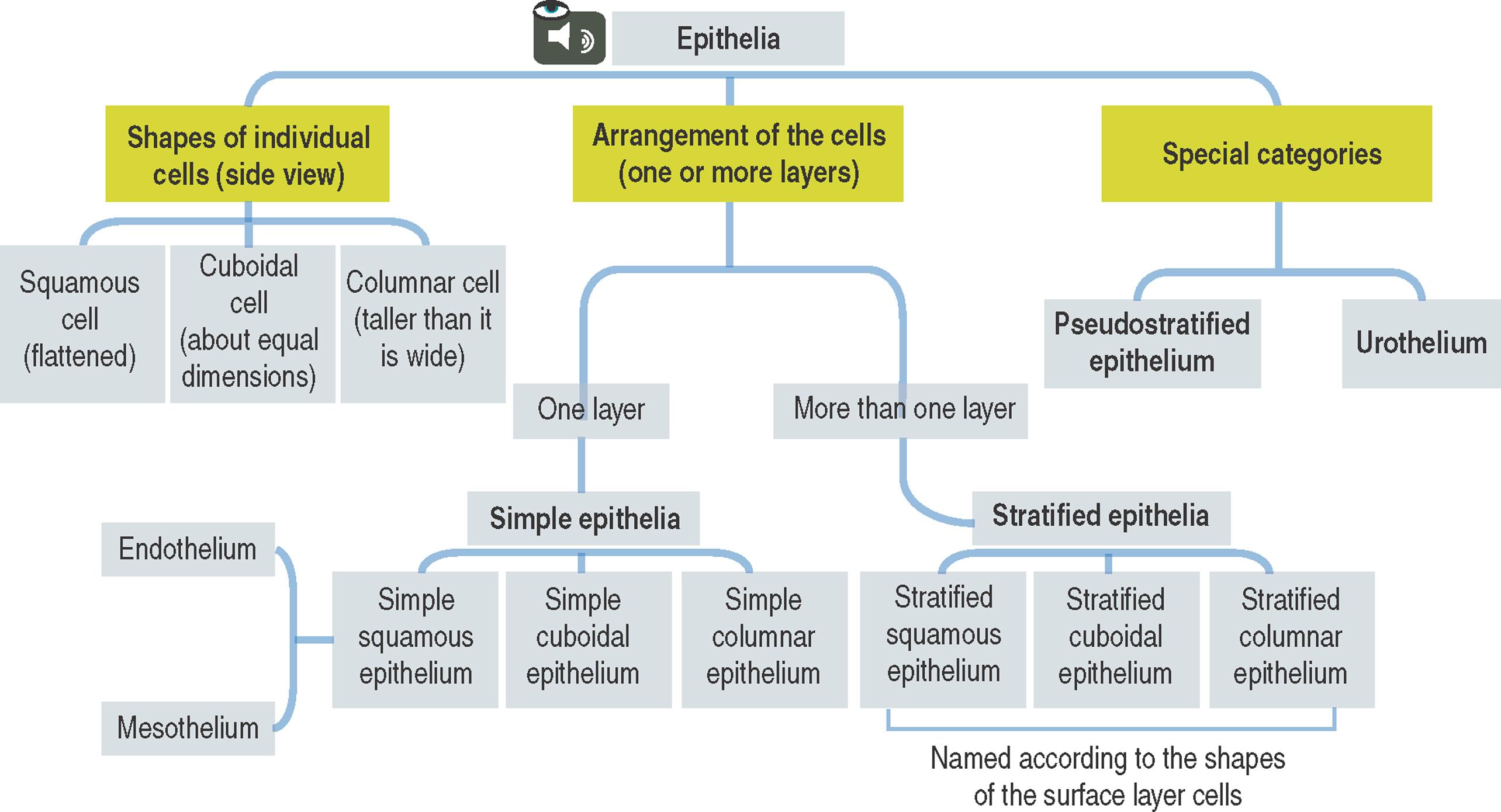
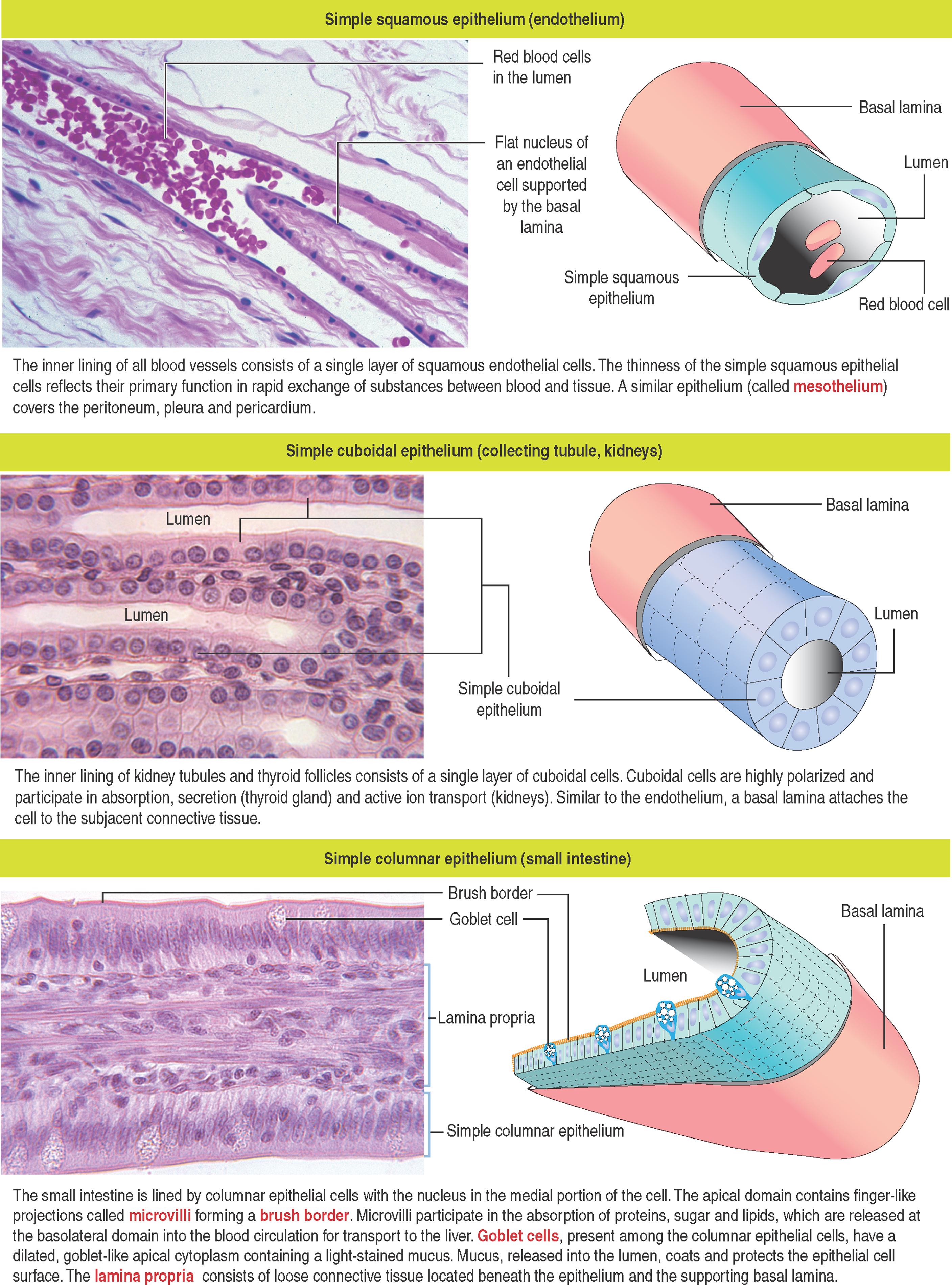
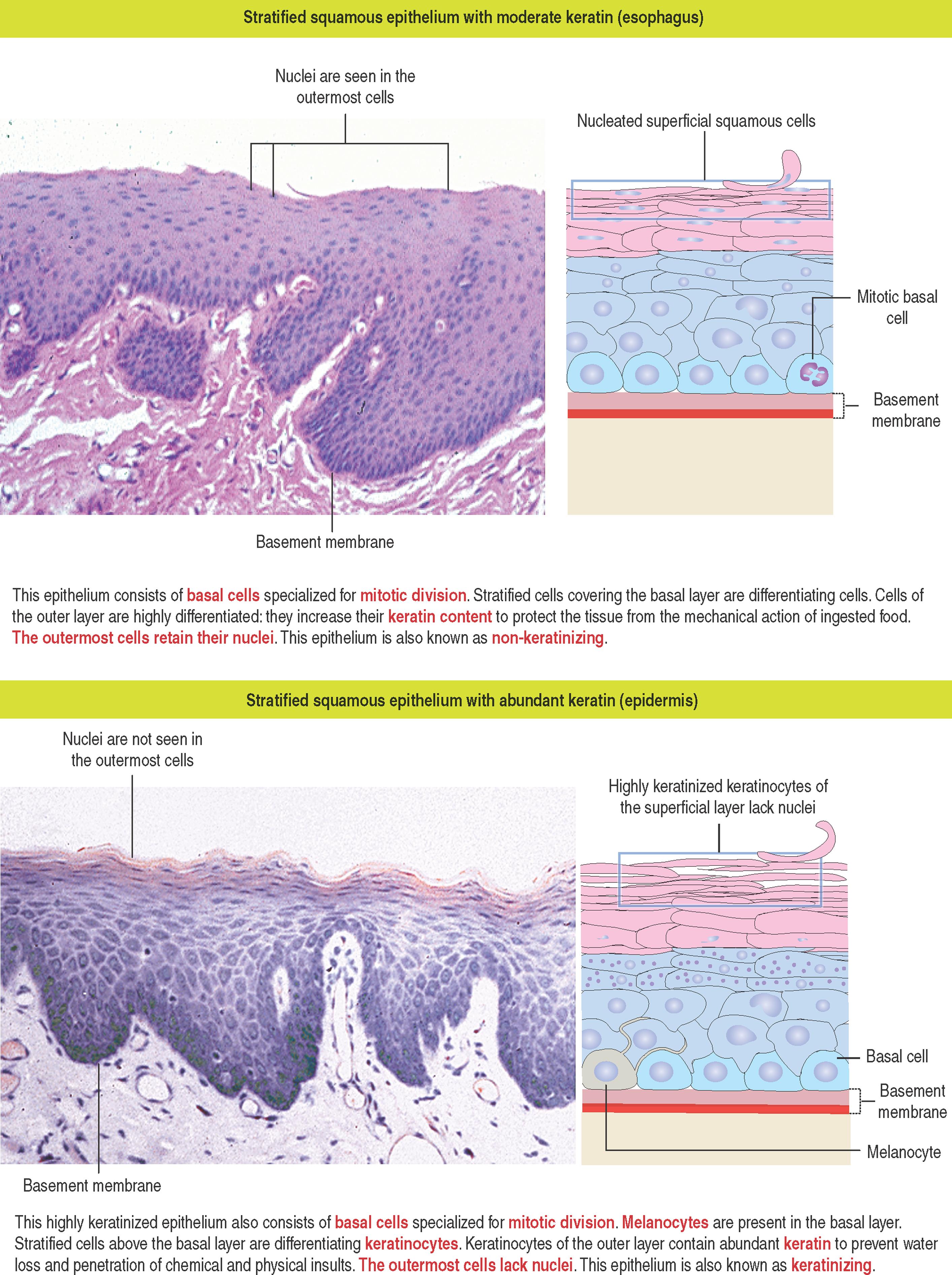
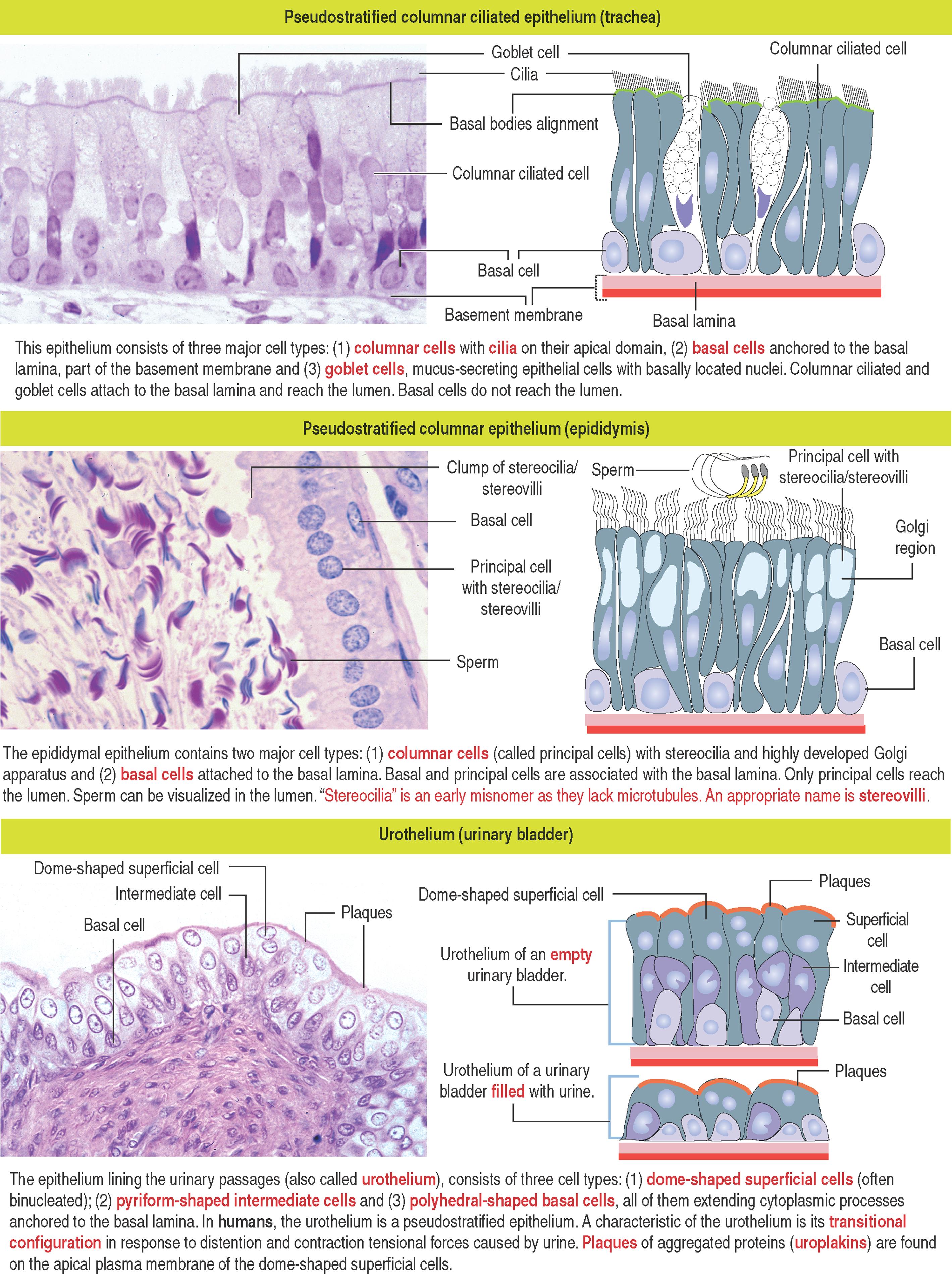
Epithelia derive from the ectoderm, mesoderm and endoderm.
Epithelia line and cover all body surfaces except the articular cartilage, the enamel of the tooth and the anterior surface of the iris.
The basic functions of epithelia are protection (skin), absorption (small and large intestine), transport of material at the surface (mediated by cilia), secretion (glands), excretion (tubules of the kidneys), gas exchange (lung alveolus) and gliding between surfaces (mesothelium).
Most epithelial cells renew continuously by mitosis.
Epithelia lack a direct blood and lymphatic supply. Nutrients are delivered by diffusion.
Epithelial cells have almost no free intercellular substances (in contrast to connective tissue).
The cohesive nature of an epithelium is maintained by cell adhesion molecules and junctional complexes .
Epithelia are anchored to a basal lamina . The basal lamina and connective tissue components cooperate to form the basement membrane .
Epithelia have structural and functional polarity .
The traditional classification and nomenclature of different types of epithelia are based on two parameters:
The shapes of individual cells .
The arrangement of the cells in one or more layers .
Individual epithelial cells can be flattened ( squamous cells ), have equal dimensions ( cuboidal cells ) and be taller than wider ( columnar cells ).
According to the number of cell layers, an epithelium consisting of a single cell layer is classified as simple epithelium .
Simple epithelia , in turn, are subdivided into simple squamous epithelium, simple cuboidal epithelium and simple columnar epithelium , according to the shape of their cell components. The specific name endothelium is used for the simple squamous epithelium lining the blood and lymphatic vessels. Mesothelium is the simple squamous epithelium lining all body cavities (peritoneum, pericardium and pleura).
Stratified epithelia are composed of more than one cell layer . Stratified epithelia are subclassified according to the shapes of the cells at the superficial or outer layer into stratified squamous epithelium, stratified cuboidal epithelium and stratified columnar epithelium .
Stratified squamous is the epithelium most frequently found and can be subdivided into moderately keratinized (also known as non-keratinizing) or highly keratinized types. The cells of the outer layer of a non-keratinizing squamous epithelium retain nuclei (for example, esophagus and vagina). Nuclei are absent in the outer layer of the highly keratinized stratified squamous epithelium (for example, the epidermis of the skin).
Stratified epithelia have basal cells aligned along the basal lamina. Basal cells are mitotically active and continuously replace the differentiating cells of the upper layers.
Although rare, there are also stratified cuboidal epithelia (for example, in the ovarian follicles and lining the intralobular ducts of salivary glands).
Two special categories are the pseudostratified epithelium and the urothelium . The pseudostratified epithelium consists of basal and columnar cells resting on the basal lamina. Only the columnar cells reach the luminal surface. Because the nuclei of the basal and columnar cells are seen at different levels, one has the impression of a stratified epithelial organization.
Within this category are the pseudostratified columnar ciliated epithelium of the trachea and the pseudostratified columnar epithelium with stereocilia of the epididymis.
The epithelium of the human urinary passages, also referred to as urothelium , has the characteristics of a pseudostratified epithelium. It consists of basal cells, intermediate cells and columnar dome-shaped cells, each extending thin cytoplasmic processes reaching the basal lamina. An important feature of this epithelium is its transitional height that varies with distention and contraction of the organ.
An important aspect of an epithelium is its polarity . Polarity is essential to carry out specific functions of the various organ systems. Polarity is determined by the distribution of plasma membrane proteins and lipids and the rearrangement of the cytoskeleton.
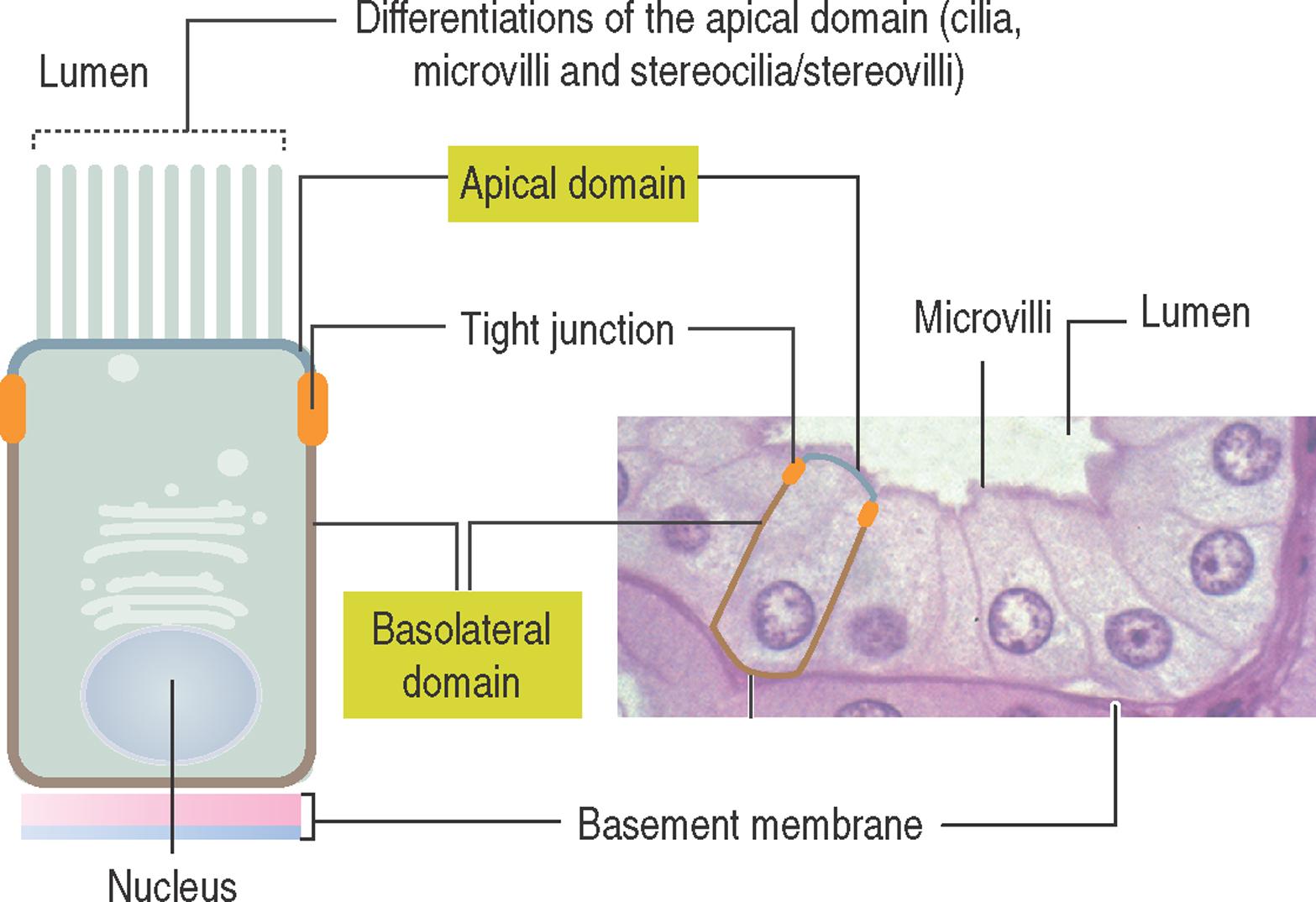
Most epithelial cells lining surfaces and cavities have three geometric domains:
The apical (uppermost) domain is exposed to the lumen or external environment and displays apical differentiations .
The l ateral domain faces neighboring epithelial cells linked to each other by cell adhesion molecules and junctional complexes .
The basal domain is associated with a basal lamina that separates the epithelium from underlying connective tissue, representing the internal and nutritional supporting environment.
The basal lamina, of epithelial cell origin, is reinforced by components of the connective tissue. The basal lamina–connective tissue complex is designated the basement membrane .
From the functional perspective, sealing junctions segregate the plasma membrane of an epithelial cell into an apical domain and a basolateral domain .
This segregation is supported by the asymmetric distribution of transporting molecules, ensuring polarized secretory and absorptive functions of an epithelium. For example, the apical domain has structures important for the protection of the epithelial surface (such as cilia in the respiratory tract) or for the absorption of substances (such as microvilli in the intestinal epithelium). In contrast, the basolateral domain facilitates directional or vectorial transport functions prevented from trespassing the sealing junctions.
The apical domain of some epithelial cells can display three types of differentiation:
Cilia .
Microvilli .
Stereocilia .
There are two types of cilia (singular, cilium): multiple motile cilia and a single or a primary non-motile cilium .
Ciliogenesis , the assembly process of both types of cilia, is initiated by the basal body , a structure originated from a basal body precursor located in the centrosome .
Basal bodies migrate to the apical plasma membrane and extend into the extracellular space.
Multiple motile cilia function to coordinate fluid or cargo flow on the surface of an epithelium . They are cell projections originating from basal bodies anchored by rootlets to the apical portion of the cytoplasm.
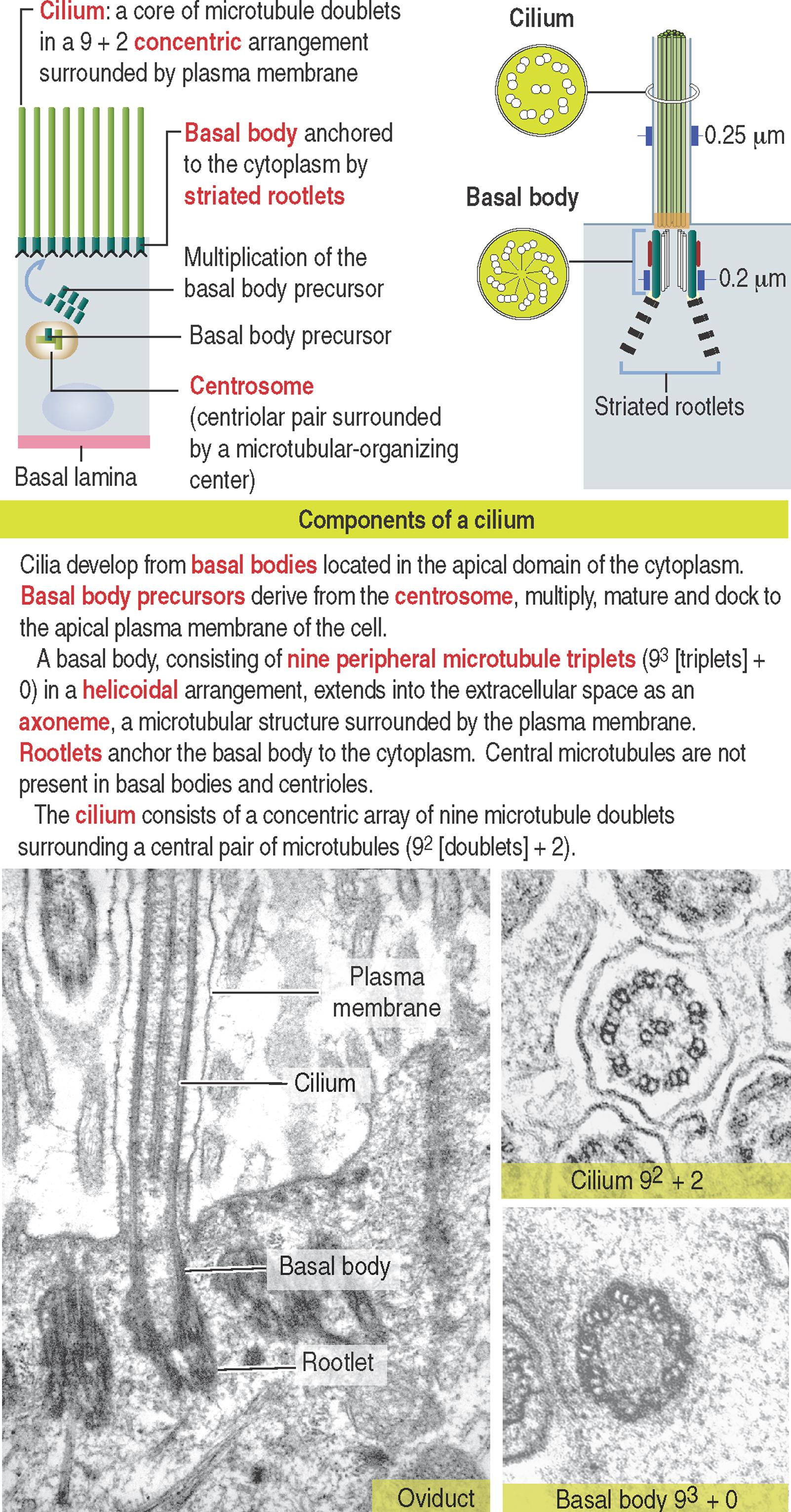
A basal body contains nine triplet microtubules in a helicoid array without a central microtubular component. By contrast, a cilium consists of an axoneme formed by a central pair of microtubules surrounded by nine concentrically arranged microtubular pairs. This assembly is known as the 9 + 2 microtubular doublet arrangement . The axoneme is also a component of the sperm tail, or flagellum .
The trachea and the oviduct are lined by ciliated epithelial cells . In these epithelia, ciliary activity is important for the local defense of the respiratory system and for the transport of the fertilized egg to the uterine cavity.
Ciliary motility is characterized by wide asymmetric bending motions . In contrast, flagellar motility is defined by a symmetric sine-wave bending pattern .
Some cells have a single or primary non-motile cilium. The importance of a single cilium emerges from rare recessive human disorders known as ciliopathies , caused by structural or functional abnormalities of cilia.
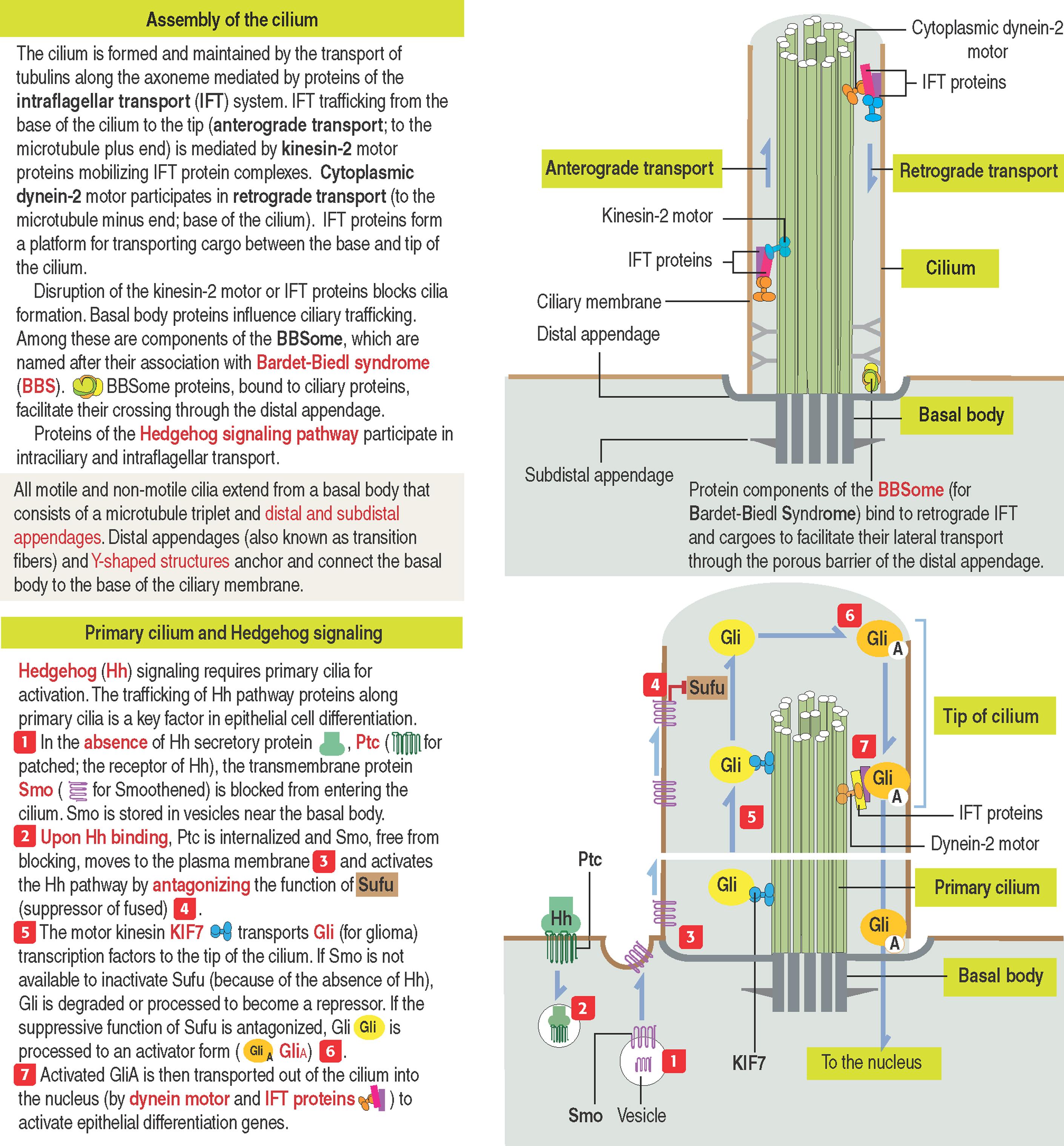
The significant aspects of a primary cilium are:
It functions as a sensor , providing the cell with information about the surrounding environment.
It participates in the early stages of embryonic patterning, leading to organogenesis.
Many components of the Hedgehog signaling pathway, essential at least in early development, are present in a single cilium.
The position of the single cilium, called kinocilium , of the hair cell of the organ of Corti in the inner ear determines the correct polarity of the adjacent actin-containing stereocilia, essential for maintaining body balance and for hearing.
Microvilli (singular, microvillus) are finger-like cell projections of the apical epithelial cell surface containing a core of cross-linked microfilaments (a polymer of G-actin monomers).

At the cytoplasmic end of the microvillus, bundles of actin and other proteins extend into the terminal web , a filamentous network of cytoskeletal proteins running parallel to the apical domain of the epithelial cell.
The intestinal epithelium and portions of the nephron in the kidney are lined by epithelial cells with microvilli forming a brush border . In general, a brush border indicates the absorptive function of the cell.
Stereocilia (singular, stereocilium) are long and branching finger-like projections of the apical epithelial cell surface. Similar to microvilli, stereocilia contain a core of cross-linked actin with other proteins.
Stereocilia (or stereovilli) do not have axonemes . Stereocilia/stereovilli are typical of the epithelial lining of the epididymis and contribute to the process of sperm maturation occurring in this organ.
A sheet of epithelial cells results from the tight attachment of similar cells to each other and to the basal lamina , a component of the extracellular matrix. Cell adhesion molecules enable interepithelial cell contact and this contact is stabilized by specialized cell junctions . A consequence of this arrangement is the apical and basolateral domain polarity of an epithelial sheet.
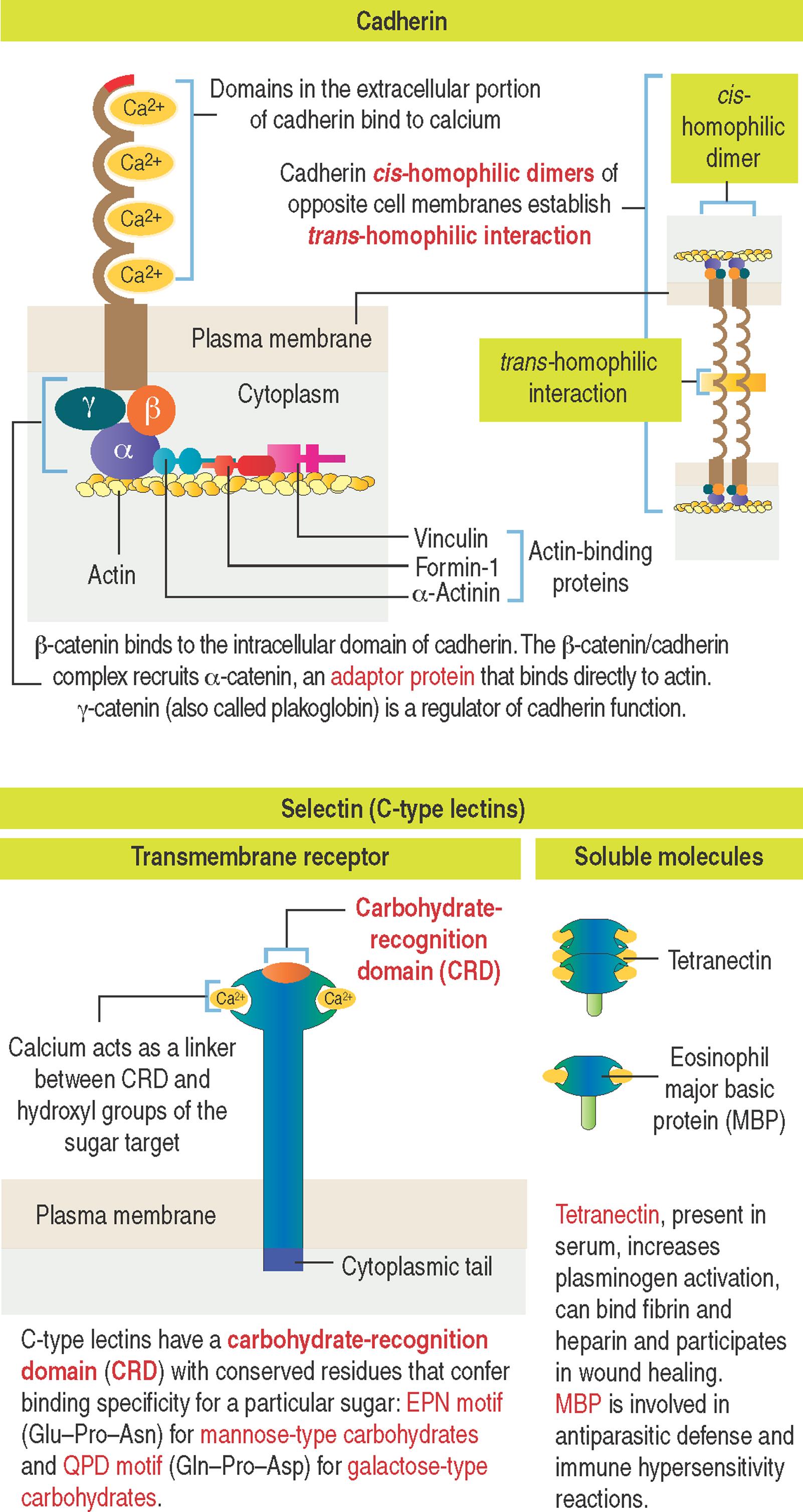
There are two major groups of cell adhesion molecules:
Ca 2+ -dependent molecules , including cadherins and selectins .
Ca 2+ -independent molecules , including the immunoglobulin-like cell adhesion molecules superfamily and integrins .
Many cells can use different cell adhesion molecules to mediate cell-cell attachment. Integrins are mainly involved in cell–extracellular matrix interactions. Cadherins and integrins establish a link between the internal cytoskeleton of a cell and the exterior of another cell (cadherins) or the extracellular matrix (integrins).
Cadherins are a family of Ca 2+ -dependent molecules with a major role in cell adhesion and morphogenesis.
A loss of E-cadherins is associated with the acquisition of invasive behavior by tumor cells (metastasis), as we discuss in Chapter 4 , Connective Tissue and Chapter 17 , Digestive Glands.
There are more than 80 different cadherins, including desmogleins and desmocollins . Classical cadherins were originally named for the tissue in which they were particularly expressed–for example, epithelial cadherin (E-cadherin) in epithelial cells; neural cadherin (N-cadherin) in the nervous system; vascular endothelial cadherin (V-cadherin) in endothelia; and placenta cadherin (P-cadherin) .
E-cadherin is found along the lateral cell surfaces and is responsible for the maintenance of most epithelial layers. The removal of calcium or the use of a blocking antibody to E-cadherin in epithelial cell cultures breaks down cell-cell attachment and the formation of stabilizing junctions is disrupted.
E-cadherin molecules form cis -homophilic dimers („like-to-like”), which bind to dimers of the same or different class of cadherins in the opposite cell membrane ( trans -homophilic or heterophilic [„like-to-unlike”] interaction) . These forms of binding require the presence of calcium and result in a specialized zipper-like cell-cell adhesion pattern.
The cytoplasmic domain of cadherins is linked to actin through intermediate proteins known collectively as the catenin (Latin catena , chain) complex . The complex includes catenins α, β and γ and actin-binding proteins α -actinin, vinculin and formin-1 , among others).
The catenin complex has at least three distinct roles in the function of cadherins:
The protein α-catenin mediates a direct link to filamentous actin.
Catenins interact with regulatory molecules of the actin cytoskeleton.
Catenins control the adhesive state of the extracellular domain of cadherins.
The association of actin to the cadherin-catenin complex is essential for cell morphogenesis, changes in cell shape and the establishment of cell polarity.
Members of the cadherin family also are present between cytoplasmic plaques of the zonula and the macula adherens. β-catenin plays a significant role in colorectal carcinogenesis (see Chapter 16 , Lower Digestive Segment).
Selectins, similar to cadherins, are Ca 2+ -dependent cell adhesion molecules. In contrast to cadherins, selectins bind to carbohydrates and belong to the family of C-type lectins (Latin lectum , to select).
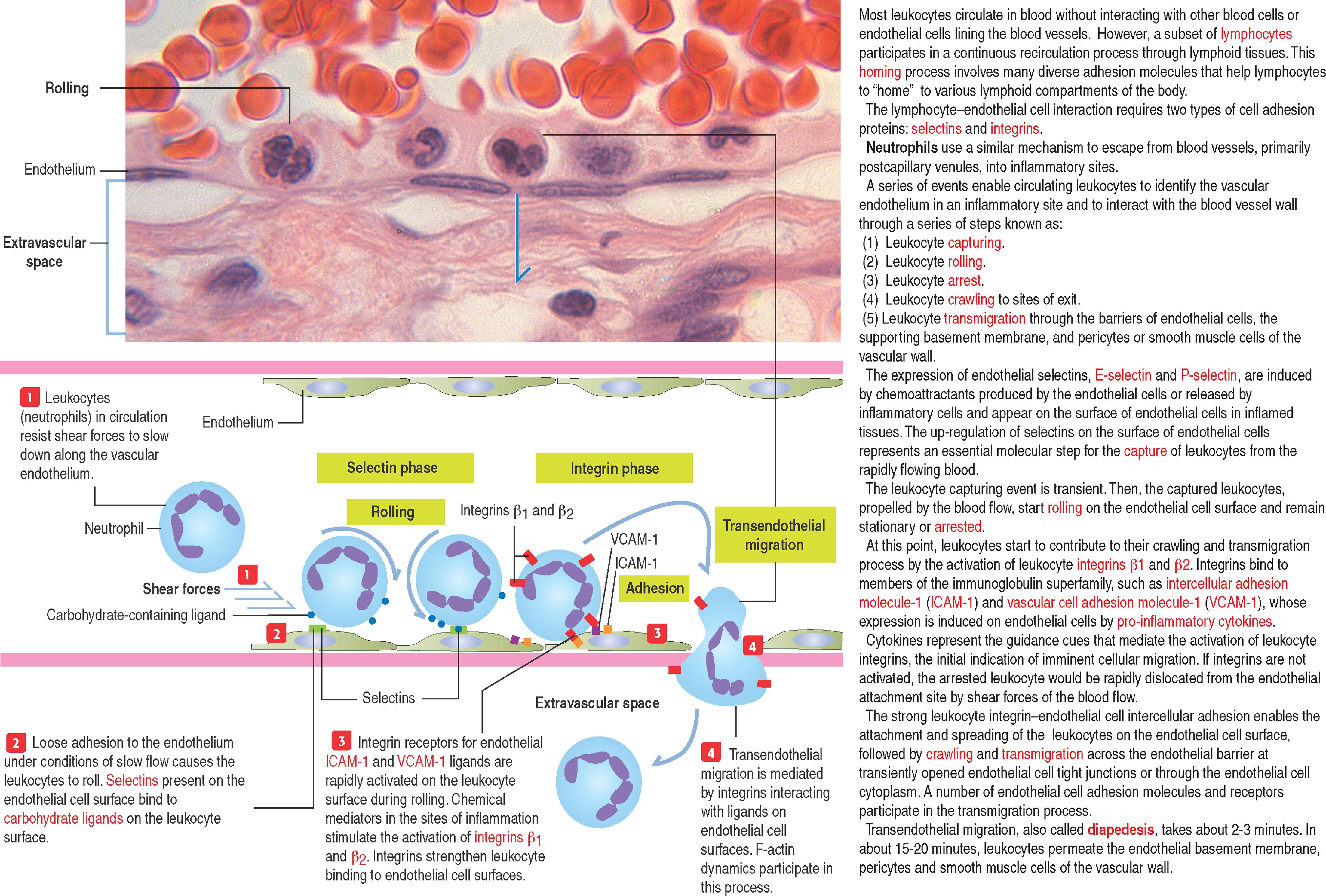
Each C-type selectin (for calcium requiring) has a carbohydrate-recognition domain (CRD) of 120 amino acids with binding affinity to a specific oligosaccharide attached to a protein (glycoprotein) or a lipid (glycolipid). The molecular configuration of the CRD is controlled by calcium . Calcium acts as a linker between the CRD and the hydroxyl groups of the sugar target.
There are three major classes of cell surface C-type lectins:
P-selectin , found in activated p latelets and activated endothelial cells lining blood vessels.
E-selectin , found on activated e ndothelial cells.
L-selectin , found in l eukocytes.
C-type lectins are transmembrane receptors ( CLRs) involved in antimicrobial immunity and autoimmunity but can also be found as soluble molecules (growth factors, antimicrobial proteins and components of the extracellular matrix).
CLRs can activate signaling pathways resulting in the activation or inhibition of cellular functions. For example, a signalling pathway can induce primarily nuclear factor-κB (NF-κB )-dependent proinflammatory responses. Some others can promote and suppress antitumour immune responses, such as in natural killer (NK) cells, where C-type lectins facilitate the recognition of cancer cells and prevent the attack of healthy cells by inducing the cytotoxic activities of NK cells. Yet, metastasis of cancer cells is increased by expression of C-type lectins, such as L-selectin, which facilitates cancer cell adherence to the endothelium.
Selectins participate in the movement of leukocytes (Greek leukos , white, kytos , cell) circulating in blood (neutrophils, monocytes, B and T cells) toward tissues by extravasation .
Extravasation is the essence of homing , a mechanism that enables leukocytes to escape from blood circulation and reach the sites of inflammation. Homing also permits thymus-derived T cells to home in peripheral lymph nodes.
P-selectin is stored in cytoplasmic vesicles in endothelial cells. When endothelial cells are activated by inflammatory signaling, P-selectin appears on the cell surface.
On their surface, leukocytes contain sialyl Lewis-x antigen , a specific oligosaccharide ligand for P-selectin. P-selectin binding to the antigen slows down streaming leukocytes in blood and they begin to roll along the endothelial cell surfaces. P-selectins get additional help from members of the superfamily of immunoglobulin-like cell adhesion molecules and integrins to stabilize leukocyte attachment, leading to extravasation.
In contrast to cadherins and selectins, members of the Ig-CAMs superfamily are Ca 2+ -independent cell adhesion molecules and are encoded by a single gene. Members of the Ig superfamily are generated by the alternative messenger RNA (mRNA) splicing and have differences in glycosylation.
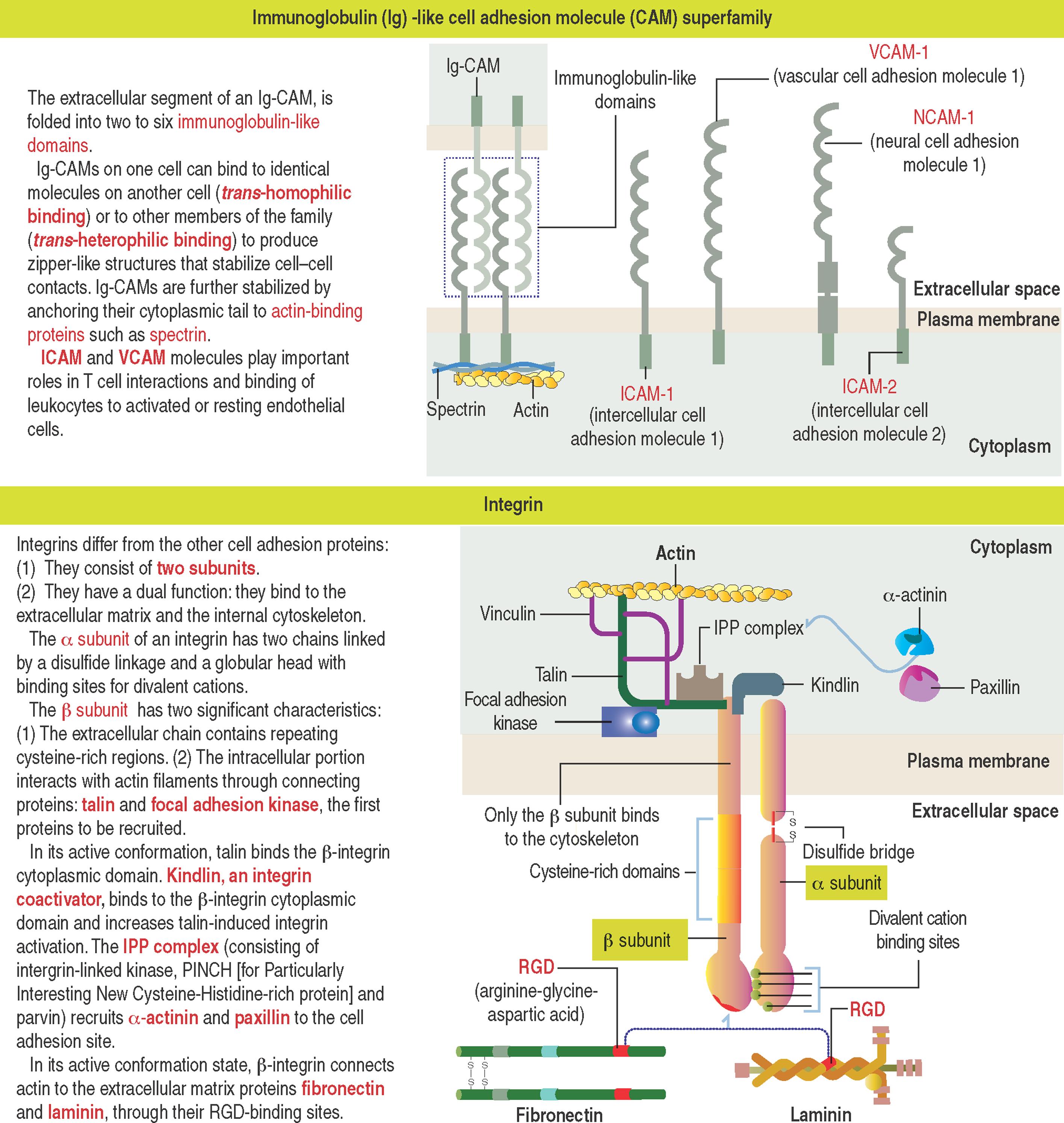
A conserved feature shared by all members of the Ig superfamily is an extracellular segment with one or more folded loops characteristic of immunoglobulins .
Similar to cadherins, cell–cell adhesion takes place by homophilic interactions between Ig-CAMs, although for Ig-CAMs the binding is Ca 2+ -independent. The cytoplasmic tail of the Ig-CAMs is associated with components of the cytoskeleton, such as actin, ankyrins and spectrin.
In addition to their cell adhesion properties, Ig-CAMs mediate adhesion-independent signaling by interacting with growth factor receptors, transcription cofactors and other signaling proteins.
Ig-CAMs are dysfunctional in a broad range of diseases such as cancer, vasculopathies, epithelial and neurological disorders.
Of particular interest is CD4 , a member of the Ig-CAM superfamily and the receptor for the human immunodeficiency virus type 1 (HIV-1) in a subclass of lymphocytes known as T cells or helper cells.
We discuss the significance of several members of the Ig superfamily in Chapter 10 , Immune-Lymphatic System.
Other members of the Ig-CAM superfamily play important roles in the homing process during inflammation. Examples include intercellular adhesion molecules 1 and 2 (ICAM-1 and ICAM-2) on endothelial cell surfaces. ICAM-1 is expressed when an inflammation is in progress to facilitate the transendothelial migration of leukocytes (see Chapter 6 , Blood and Hematopoiesis).
Members of the ADAM family (for a n extracellular d isintegrin a nd m etalloprotease) are sheddases that can cleave and release the soluble ectodomain of various Ig-CAMs. The released, or shedded , protein fragments are involved in biological activities such the activation of growth factor receptors.
Integrins differ from cadherins, selectins and members of the Ig superfamily in that integrins are heterodimers formed by two associated αand β subunits encoded by different genes (see 1-9 ). There are about 22 integrin heterodimers consisting of 17 forms of αsubunits and 8 forms of βsubunits.
Almost every cell expresses one or several integrins. Similar to cadherins, the cytoplasmic domain of βintegrin subunit is linked to actin filaments through connecting proteins (see 1-9 ).
The extracellular domain of βintegrin subunit binds to the tripeptide RGD (Arg-Gly-Asp) sequence present in laminin and fibronectin , two major components of the basement membrane, a specific type of extracellular matrix. Laminin and fibronectin interact with various collagen types (including type IV collagen) , h eparan sulfate proteoglycan perlecan and entactin (also called nidogen).
The integrin–extracellular matrix relationship is critical for cell migration to precise sites during embryogenesis and can be regulated when cell motility is required. In addition to their role in cell-matrix interactions , integrins also mediate cell-cell interaction .
Integrins, containing β 2 subunits, are expressed on the surface of leukocytes and mediate cell-cell binding in preparation for extravasation. An example is α 1 β 2 integrin on non-adherent leukocytes that bind to ligands on endothelial cell surfaces following activation by extracellular stimulation, resulting in leukocyte extravasation during the recruitment of leukocytes to extravascular spaces (see Primer 1-B ).
Integrins are bidirectional signaling receptors . Integrins can be activated by proteins binding to their extracellular and intracellular domains. When integrins bind to extracellular matrix molecules, a protein complex binds to the cytoskeleton and several signaling pathways are activated.
Genetic mutations of integrins or integrin regulators have been associated with Glanzmann's thromboasthenia (mutations in β 3 integrin subunit), leukocyte adhesion deficiency (type I , caused by mutations in β 2 integrin subunit; type II , resulting from the absence of fucosyl-containing ligands for selectins due to a hereditary defect of endogenous fucose metabolism; and type III , determined by mutations in kindlin) and skin diseases (mutations in kindlin, α 2 , α 6 and β 4 integrin subunits).
Integrin-mediated cell binding to extracellular ligands can be disrupted by ADAM sheddases (see Primer 1-C ). ADAMs have roles in fertilization, angiogenesis, neurogenesis, heart development, cancer and Alzheimer's disease.
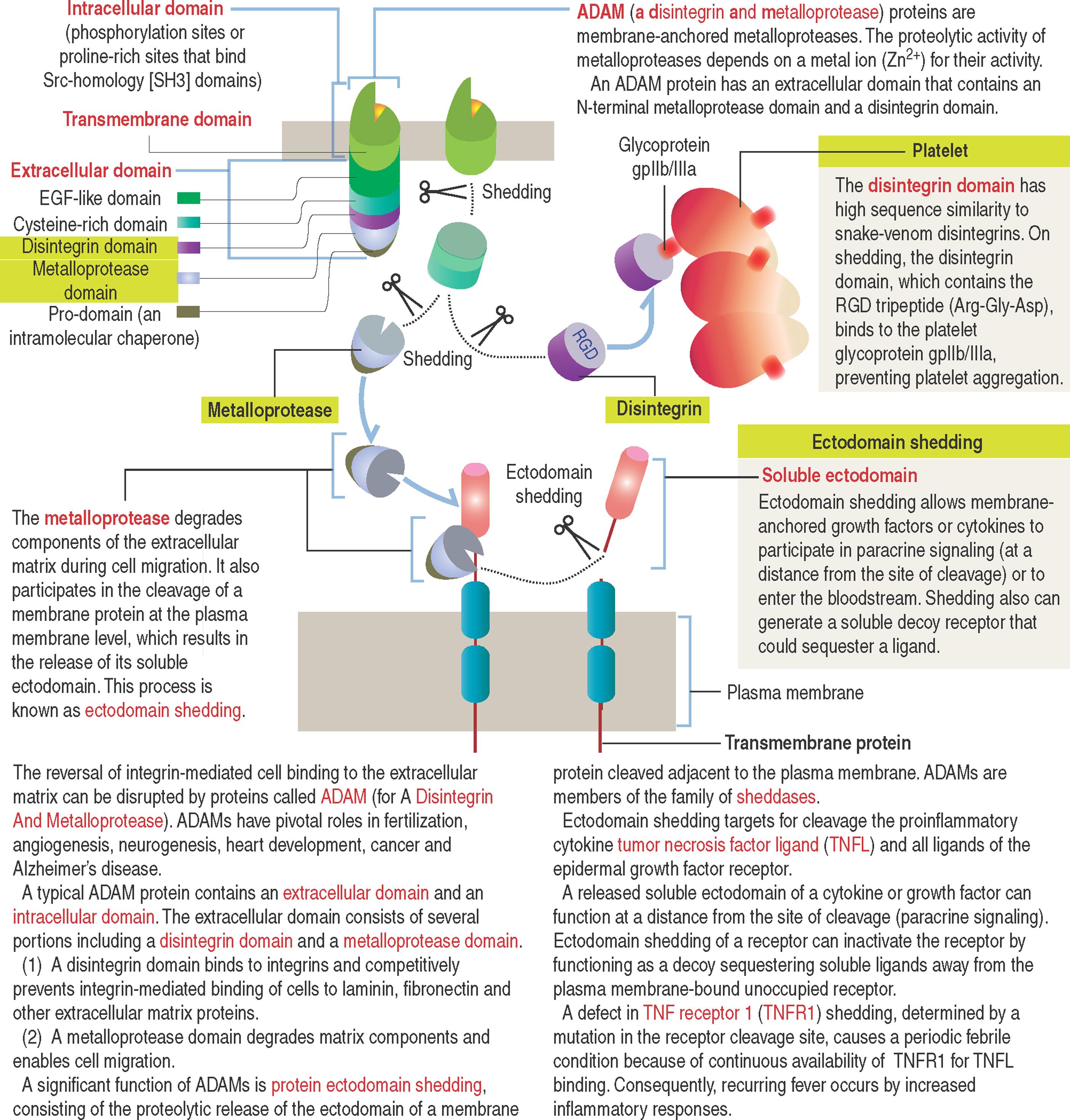
Although cell adhesion molecules are responsible for cell-cell adhesion, cell junctions are necessary for providing stronger stability to epithelia and also for separating different tissue compartments from the external environment.
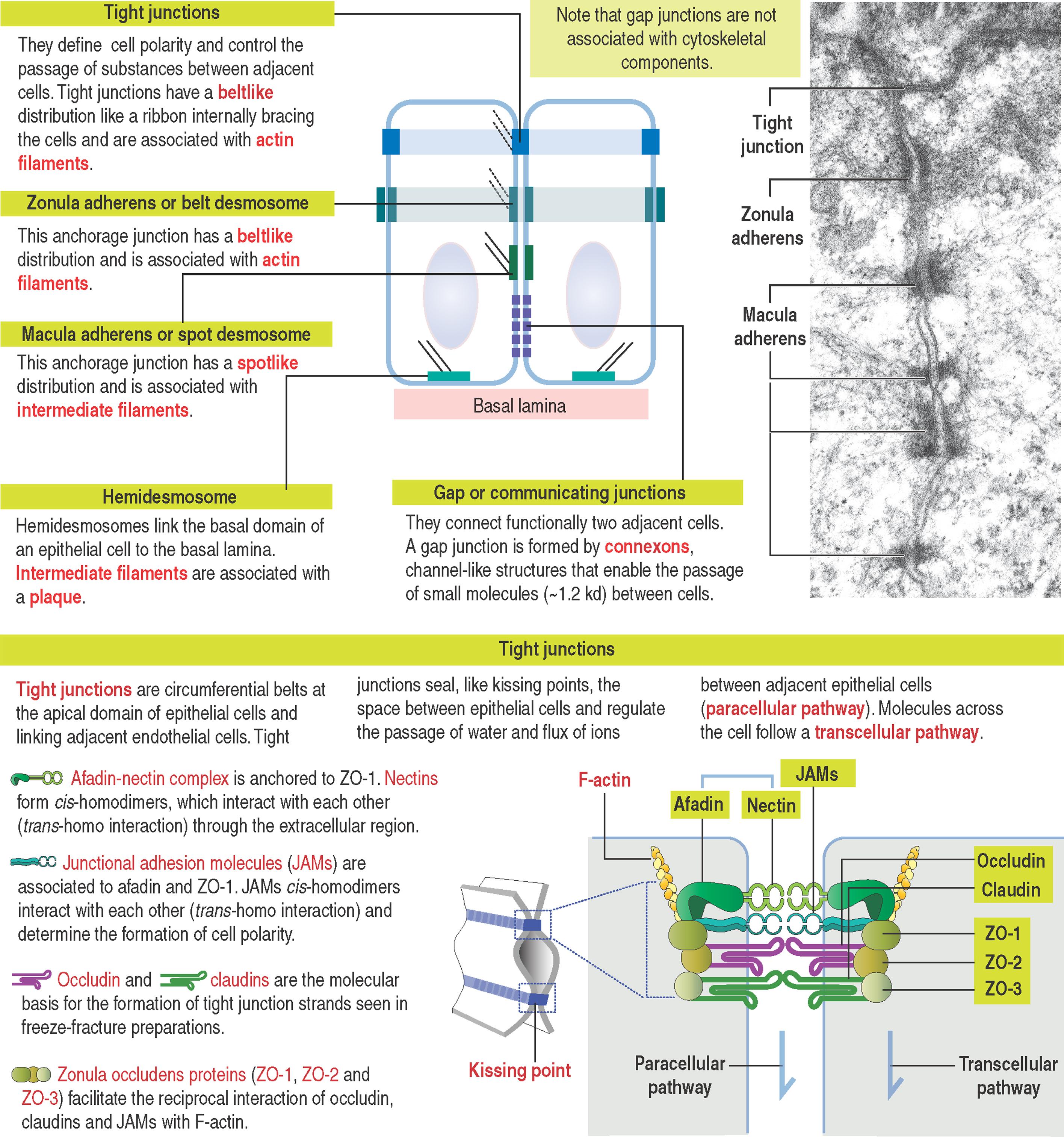
The movement of solutes, ions and water through an epithelial layer occurs across and between individual cell components. The transcellular pathway is controlled by numerous channels and transporters whereas the paracellular pathway is regulated by continuous intercellular contacts or cell junctions .
Cell junctions are symmetrical structures formed between two adjacent epithelial cells. An exception is the hemodesmosome, an asymmetrical structure anchoring the basal domain of an epithelial cell to the basal lamina.
There are four major classes of cell junctions:
Tight junction .
Adherens junctions , including zonula adherens (belt desmosome) and macula adherens (spot desmosome).
Hemidesmosome .
Gap or communicating junction .
Tight junctions (also called occluding junctions) have three major functions:
They determine epithelial cell polarity by separating the apical domain from the basolateral domain and preventing the free diffusion of lipids and proteins between them.
They prevent the free passage of substances across an epithelial cell layer, creating gates that control the paracellular diffusion of ions and solutes.
Apart from serving as permeability barriers, tight junctions are connected to signaling networks that regulate proliferation and cell differentiation and transmit information to and from the cytoskeleton, the nucleus and different cell adhesion complexes.
Cell membranes of two adjacent cells come together at regular intervals to seal the apical intercellular space. These areas of close contact continue around the entire surface of the cell like a belt, forming anastomosing strips of the transmembrane proteins occludin and claudin . Occludin and claudin belong to the family of tetraspanins with four transmembrane domains, two outer loops and two short cytoplasmic tails.
Occludin interacts with four major zonula occludin (ZO) proteins: ZO-1, ZO-2, ZO-3 and afadin .
Claudin (Latin claudere , to close), a family of 16 proteins forming linear fibrils in the tight junctions, confers barrier properties on the paracellular pathway.
A mutation in the gene encoding claudin 16 is the cause of a rare human renal magnesium wasting syndrome characterized by hypomagnesemia and seizures (see Box 1-B ).
Several diseases affecting tissues and organs have been related to tight junctions. Some diseases are caused by mutations in tight junction-associated proteins or by viral and bacterial infections targeting tight junctions.
A number of diseases, such as chronic inflammation and cancer, are associated with dysfunctional tight junctions.
Junctional protein-associated genetic diseases
Claudin 1: Neonatal ichthyosis; sclerosing cholangitis.
Claudin 5: Velo-cardial-facial syndrome.
Claudin 16: Familial hypomagnesemia.
Claudin 19: Familial hypomagnesemia, hypercalciuria and nephrocalcinosis.
Junctional protein targeted by a virus/bacterium
Claudin 1, claudin 6, claudin 9 and occludin: Hepatitis C virus infection.
JAMs: Infection caused by retroviruses.
Occludin: Vibrio cholera infection.
ZO1, ZO2: Dengue virus infection.
Two members of the Ig superfamily, nectins and junctional adhesion molecules (JAMs) , are present in tight junctions. Both form homodimers ( cis -homodimers) and trans -homodimers across the intercellular space.
Nectins are connected to actin filaments through the protein afadin. The targeted deletion of the afadin gene in mice results in embryonic lethality. A mutation in the nectin-1 gene is responsible for cleft lip/palate and ectodermal dysplasia (CLEPD1) of skin, hairs, nails and teeth in humans. Nectin-2–deficient male mice are infertile .
Freeze fracture electron microscopy, a technique that enables the visualization of the hydrophobic interior of a cell membrane, reveals tight junctions as a meshwork of anastomosing sealing strands formed by rows of transmembrane particles regarded as representing the diffusion barriers.
Adherens (Latin adhaereo , sticking to) junctions include zonula adherens junctions and macula adherens junctions , both found below the tight or occluding junctions, usually near the apical surface of an epithelium (see 1-11 ).
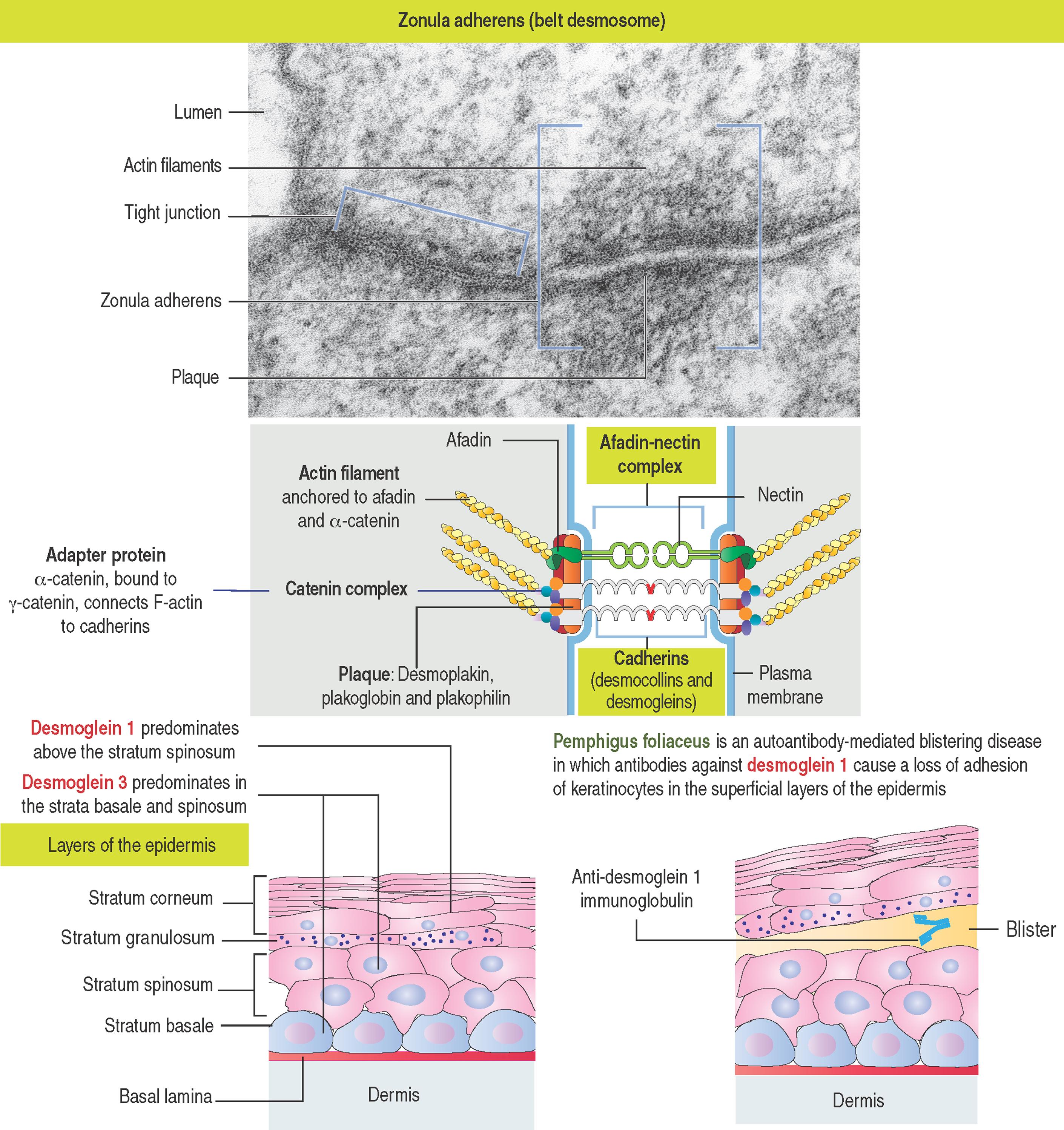
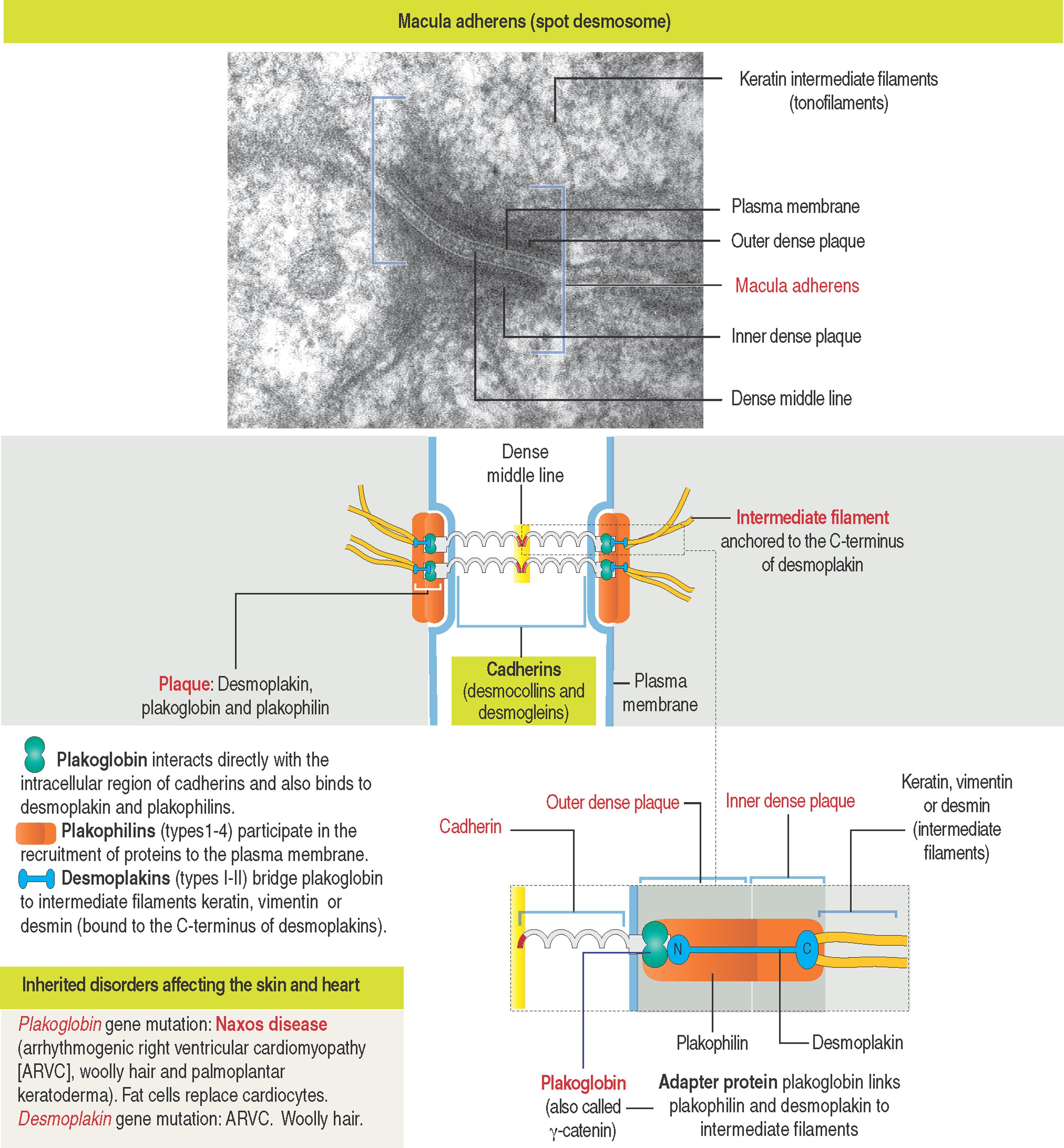
Similar to the tight junctions, zonula adherens junctions form a circumferential belt (belt desmosome) around the apical domain of epithelial cells. In contrast, macula adherens junctions in the epidermis are small, spot-like and provide strong adhesion.
Zonula adherens junctions are associated with actin microfilaments. This association is mediated by the catenin complex: α -catenin, β-catenin and g -catenin (also called plakoglobin) . β -catenin and γ-catenin bind to the cytoplasmic domains of desmocollins and desmogleins , two families of desmosomal cadherins. α-catenin, bound to β-catenin, is an adapter protein responsible for connecting the intracellular domain of cadherins to actin filaments.
Macula adherens junctions , also called spot desmosomes, are punctate-like junctions associated with keratin intermediate filaments (also known as tonofilaments) extending like ropes from one spot to another on the lateral cell surfaces of epithelial cells (see 1-12 ). Spot desmosomes provide strength, rigidity and also flexibility to an epithelial cell layer.
Desmoglein 1 and desmoglein 3 are found in the macula adherens junctions of the epidermis.
The intracellular domains of desmocollins and desmogleins are associated with plakoglobin . Plakoglobin is an adapter protein that interacts with the N-terminus globular domain of desmoplakin; the opposite C-terminus globular domain is connected to intermediate filaments (keratin, vimentin or desmin).
Plakoglobin, desmoplakin and plakophilin are components of the cytoplasmic plaques .
Note that actin microfilaments are members of the zonula adherens, whereas intermediate filaments are components of the macula adherens.
In contrast to occluding junctions, adjacent cell membranes linked by zonula and macula adherens junctions are separated by a relatively wide intercellular space. This space is occupied by the glycosylated extracellular portion of desmogleins and desmocollins, anchored to cytoplasmic plaques.
As we have already seen, the interlocking of similar cadherins connects two adjacent cells by Ca 2+ -dependent homophilic or heterophilic interaction.
It is important to emphasize that, in the stratified squamous epithelium of the epidermis, the C-terminus of desmoplakin interacts with the intermediate filaments and that desmoglein 1 and desmoglein 3 maintain the cohesiveness of the epithelium.
Autoantibodies to desmoglein-1 cause a blistering disease, called pemphigus foliaceus , by disrupting cell-cell adhesion of the upper layers of the epidermis. Autoantibodies to desmoglein-3 produce also a blistering disease, called pemphigus vulgaris , localized in the basal layers of the epidermis.
Hemidesmosomes are asymmetrical structures anchoring the basal domain of an epithelial cell to the underlying basal lamina. Hemidesmosomes increase the overall stability of epithelial tissues by linking intermediate filaments of the cytoskeleton with components of the basal lamina.
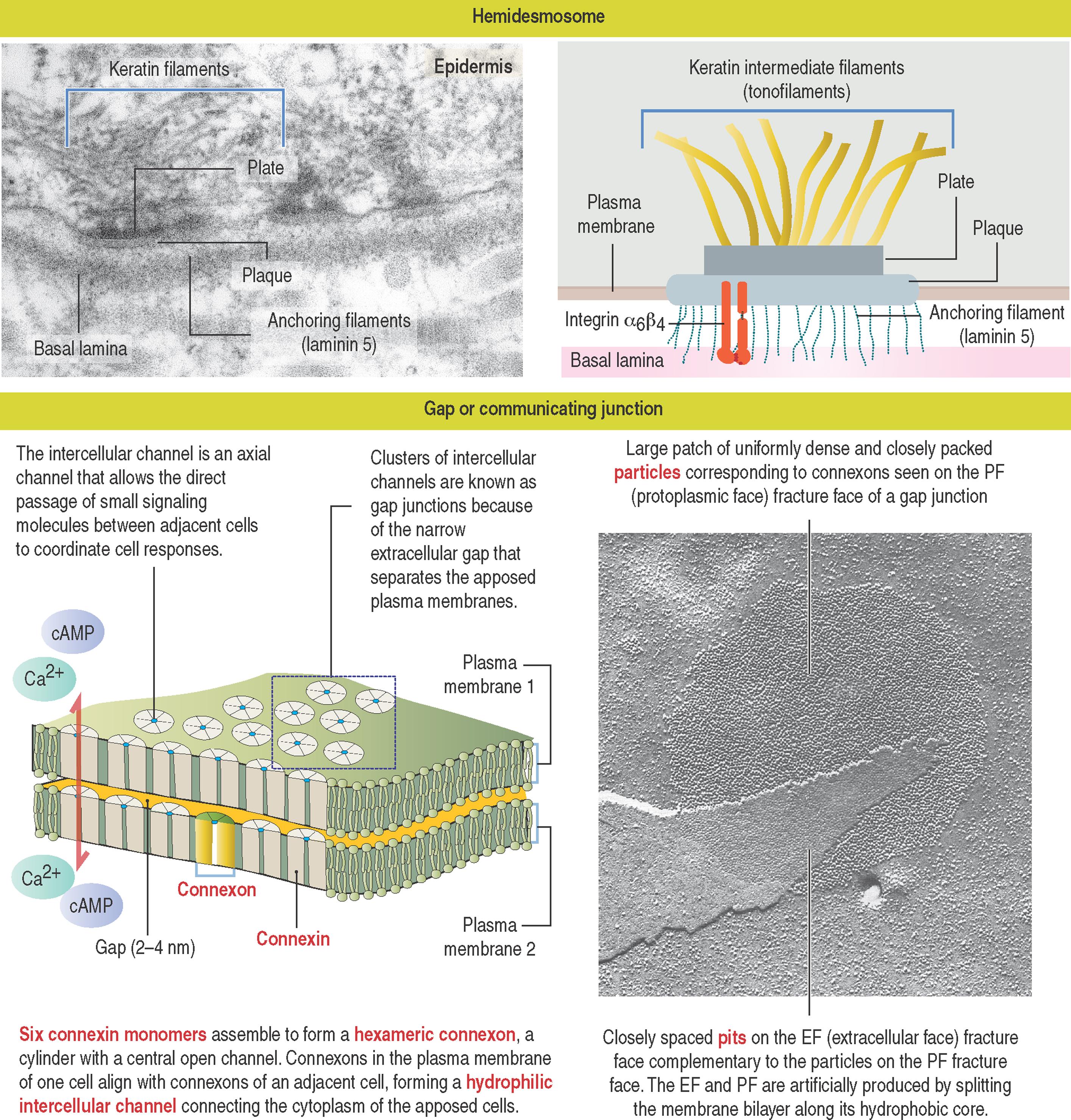
Hemidesmosomes have a different organization compared with adherens junctions. Although hemidesmosomes look like half-desmosomes, none of the biochemical components present in the desmosome is found in hemidesmosomes.
A hemidesmosome consists of these components:
An inner cytoplasmic plate associated with keratin intermediate filaments (or tonofilaments).
An outer membrane plaque linking the hemidesmosome to the basal lamina by anchoring filaments (composed of laminin 5) and integrin α 6 β 4 and proteins of the plakin family, including plectin and BPAG1 (bullous pemphigoid antigen 1) . We come back to the hemidesmosome in Chapter 11 , Integumentary System.
Gap junctions are symmetrical communicating junctions formed by integral membrane proteins called connexins.
Six connexin monomers associate to form a connexon, a hollow cylindrical structure that spans the plasma membrane.
The end-to-end alignment of connexons in adjacent cells provides a direct channel of communication (1.5 to 2 nm in diameter) between the cytoplasm of two adjacent cells. Connexons have a clustering tendency and can form patches about 0.3 mm in diameter.
Gap junctions facilitate the movement of molecules 1.2 nm in diameter between cells (for example, Ca 2+ and cyclic adenosine monophosphate, cAMP). The connexon axial channels close when the concentration of Ca 2+ is high.
Gap junctions enable the chemical and electrical „coupling” between adjacent cells. For example, cardiac muscle cells are connected by gap junctions for the transmission of electrical signals.
Become a Clinical Tree membership for Full access and enjoy Unlimited articles
If you are a member. Log in here